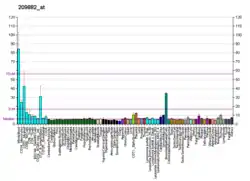RIT1
GTP-binding protein Rit1 is a protein that in humans is encoded by the RIT1 gene.[5][6][7]
| RIT1 | |||||||||||||||||||||||||||||||||||||||||||||||||||
|---|---|---|---|---|---|---|---|---|---|---|---|---|---|---|---|---|---|---|---|---|---|---|---|---|---|---|---|---|---|---|---|---|---|---|---|---|---|---|---|---|---|---|---|---|---|---|---|---|---|---|---|
| |||||||||||||||||||||||||||||||||||||||||||||||||||
| Identifiers | |||||||||||||||||||||||||||||||||||||||||||||||||||
| Aliases | RIT1, NS8, RIBB, RIT, ROC1, Ras like without CAAX 1 | ||||||||||||||||||||||||||||||||||||||||||||||||||
| External IDs | OMIM: 609591 MGI: 108053 HomoloGene: 56003 GeneCards: RIT1 | ||||||||||||||||||||||||||||||||||||||||||||||||||
| |||||||||||||||||||||||||||||||||||||||||||||||||||
| |||||||||||||||||||||||||||||||||||||||||||||||||||
| |||||||||||||||||||||||||||||||||||||||||||||||||||
| |||||||||||||||||||||||||||||||||||||||||||||||||||
| |||||||||||||||||||||||||||||||||||||||||||||||||||
| Wikidata | |||||||||||||||||||||||||||||||||||||||||||||||||||
| |||||||||||||||||||||||||||||||||||||||||||||||||||
Function
RIT belongs to the RAS (HRAS; MIM 190020) subfamily of small GTPases (Hynds et al., 2003).[supplied by OMIM][7]
Clinical significance
Mutations in RIT1 are associated to Noonan syndrome.[8]
References
- GRCh38: Ensembl release 89: ENSG00000143622 - Ensembl, May 2017
- GRCm38: Ensembl release 89: ENSMUSG00000028057 - Ensembl, May 2017
- "Human PubMed Reference:". National Center for Biotechnology Information, U.S. National Library of Medicine.
- "Mouse PubMed Reference:". National Center for Biotechnology Information, U.S. National Library of Medicine.
- Lee CH, Della NG, Chew CE, Zack DJ (November 1996). "Rin, a neuron-specific and calmodulin-binding small G-protein, and Rit define a novel subfamily of ras proteins". The Journal of Neuroscience. 16 (21): 6784–94. doi:10.1523/JNEUROSCI.16-21-06784.1996. PMC 6579259. PMID 8824319.
- Wes PD, Yu M, Montell C (November 1996). "RIC, a calmodulin-binding Ras-like GTPase". The EMBO Journal. 15 (21): 5839–48. doi:10.1002/j.1460-2075.1996.tb00971.x. PMC 452332. PMID 8918462.
- "Entrez Gene: RIT1 Ras-like without CAAX 1".
- Gos M, Fahiminiya S, Poznański J, Klapecki J, Obersztyn E, Piotrowicz M, Wierzba J, Posmyk R, Bal J, Majewski J (September 2014). "Contribution of RIT1 mutations to the pathogenesis of Noonan syndrome: four new cases and further evidence of heterogeneity". American Journal of Medical Genetics. Part A. 164A (9): 2310–6. doi:10.1002/ajmg.a.36646. PMID 24939608. S2CID 2005508.
- Rondou P, Haegeman G, Vanhoenacker P, Van Craenenbroeck K (April 2008). "BTB Protein KLHL12 targets the dopamine D4 receptor for ubiquitination by a Cul3-based E3 ligase". The Journal of Biological Chemistry. 283 (17): 11083–96. doi:10.1074/jbc.M708473200. PMC 2431063. PMID 18303015.
- Huang J, Chen J (July 2008). "VprBP targets Merlin to the Roc1-Cul4A-DDB1 E3 ligase complex for degradation". Oncogene. 27 (29): 4056–64. doi:10.1038/onc.2008.44. PMID 18332868.
Further reading
- Shao H, Kadono-Okuda K, Finlin BS, Andres DA (November 1999). "Biochemical characterization of the Ras-related GTPases Rit and Rin". Archives of Biochemistry and Biophysics. 371 (2): 207–19. doi:10.1006/abbi.1999.1448. PMID 10545207.
- Shao H, Andres DA (September 2000). "A novel RalGEF-like protein, RGL3, as a candidate effector for rit and Ras". The Journal of Biological Chemistry. 275 (35): 26914–24. doi:10.1074/jbc.M002241200. PMID 10869344.
- Hynds DL, Spencer ML, Andres DA, Snow DM (May 2003). "Rit promotes MEK-independent neurite branching in human neuroblastoma cells". Journal of Cell Science. 116 (Pt 10): 1925–35. doi:10.1242/jcs.00401. PMID 12668729.
- Li JT, Liu W, Kuang ZH, Zhang RH, Chen HK, Feng QS (February 2004). "[Mutation and amplification of RIT1 gene in hepatocellular carcinoma]". Zhonghua Yi Xue Yi Chuan Xue Za Zhi = Zhonghua Yixue Yichuanxue Zazhi = Chinese Journal of Medical Genetics. 21 (1): 43–6. PMID 14767908.
- Shi GX, Andres DA (January 2005). "Rit contributes to nerve growth factor-induced neuronal differentiation via activation of B-Raf-extracellular signal-regulated kinase and p38 mitogen-activated protein kinase cascades". Molecular and Cellular Biology. 25 (2): 830–46. doi:10.1128/MCB.25.2.830-846.2005. PMC 543422. PMID 15632082.
- Barrios-Rodiles M, Brown KR, Ozdamar B, Bose R, Liu Z, Donovan RS, Shinjo F, Liu Y, Dembowy J, Taylor IW, Luga V, Przulj N, Robinson M, Suzuki H, Hayashizaki Y, Jurisica I, Wrana JL (March 2005). "High-throughput mapping of a dynamic signaling network in mammalian cells". Science. 307 (5715): 1621–5. Bibcode:2005Sci...307.1621B. doi:10.1126/science.1105776. PMID 15761153. S2CID 39457788.
- Benmaamar R, Pagano M (September 2005). "Involvement of the SCF complex in the control of Cdh1 degradation in S-phase". Cell Cycle. 4 (9): 1230–2. doi:10.4161/cc.4.9.2048. PMID 16123585.
This article is issued from Wikipedia. The text is licensed under Creative Commons - Attribution - Sharealike. Additional terms may apply for the media files.




